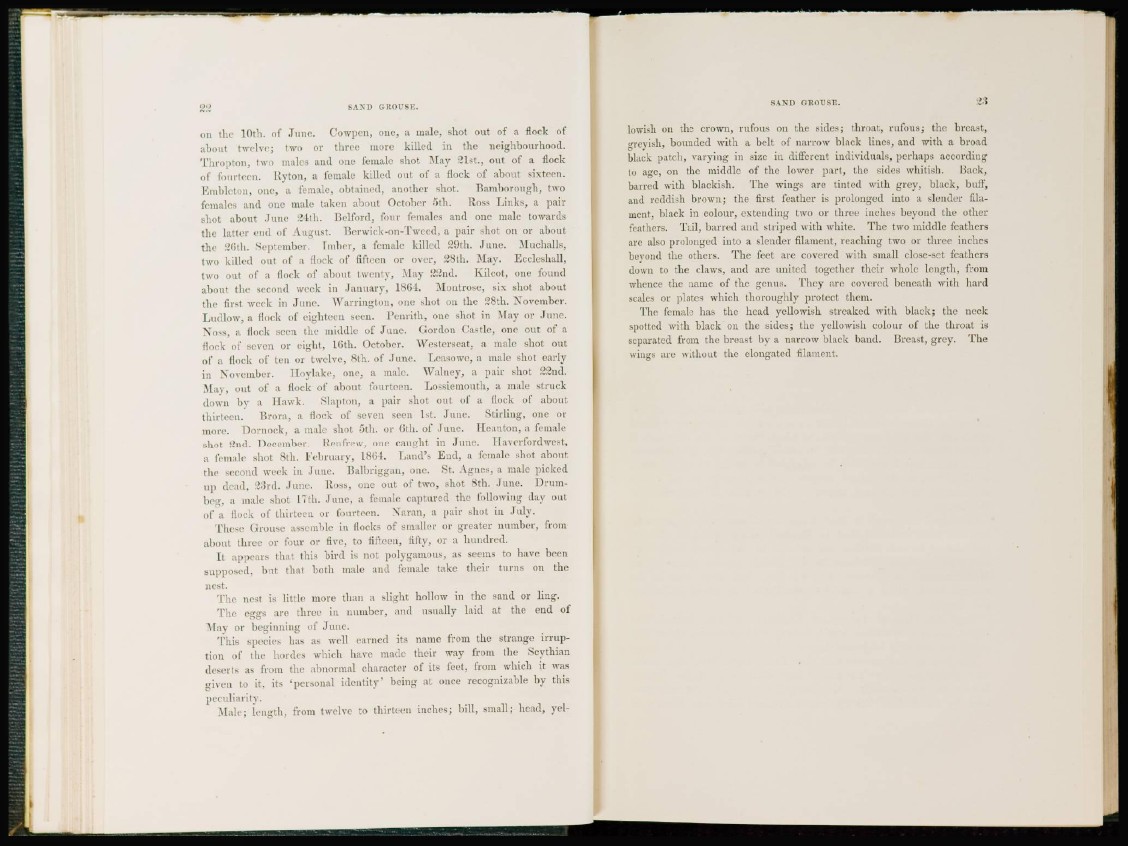
on the 10th. of June. Cowpcn, one, a male, shot out of a flock of
about twelve; two or three more killed in the neighbourhood.
T h r o p t o n , two males and one female shot May 21st., out of a flock
of fourteen. Ryton, a female killed out of a flock of about sixteen.
Embleton, one, a female, obtained, another shot. Bamborough, two
females and one male taken about October 5th. Koss Links, a pair
shot about J u n e 24th. Belford, four females and one male towards
the latter end of August. Berwick-on-Tweed, a pair shot on or about
t h e 26th. September. Imber, a female killed 29th. J u n e . Muehalls,
two killed out of a flock of fifteen or over, 28th. May. Ecclesliall,
two out of a flock of about twenty, May 2&nd. Kilcot, one found
about the second week in J a n u a r y , 1864. Montrose, six shot about
t h e first week in J u n e . Warrington, one shot on the 28th. November.
Ludlow, a Hock of eighteen seen. Penrith, one shot in May or June.
N o s s , a flock seen the middle of J u n e . Gordon Castle, one out of a
flock of seven or eight, Kith. October. Westerseat, a male shot out
of a flock of ten or twelve, 8th. of J u n e . Leasowe, a male shot early
i n November. 1 l o y l a k e , one, a male. Waluey, a pair shot 22nd.
May, out of a flock of about fourteen. Lossiemouth, a male struck
down by a Hawk. Slapton, a pair shot out of a flock of about
thirl ecu. Brora, a flock of seven seen 1st. J u n e . Stirling, one or
more. Oornock, a male shot 5th. or 6th. of J u n e . Ilcanton, a female
shot 2nd. December. Renfrew, one caught in J u n e . Haverfordwest,
a female shot 8th. F e b r u a r y , 1864. Land's End, a female shot about
t h e second week in J u u e . Balbriggau, one. St. Agnes, a male picked
up dead, 2Srd. June, ltoss, one out of two, shot 8th. J u n e . Drumbeg,
a male shot 17th. J u n e , a female captured the following day out
of a flock of t h i r t e e n or fourteen. Xaran, a pair shot in July.
These Grouse assemble in flocks of smaller or greater number, from
about three or four or five, to fifteen, fifty, or a hundred.
I t appears that this b i r d is not polygamous, as seems to have been
supposed, but thai both male and female take their turns on the
nest.
The nest is little more than a slight hollow in the sand or ling.
Tin1 eggs are three in number, and usually laid at the end of
Mav or beginning of J u n e.
This species has a s well earned its name from the strange i r r u p tion
of the hordes which have made their way from the Scythian
deserts as from the abnormal character of its feet, from which it was
given to it, its 'personal identity' being at once recognizable by this
p e c u l i a r i t y .
Male; length, from twelve to thirteen inches; bill, small; head, ycllowish
on the crown, rufous on the sides; throat, rufous; the breast,
greyish, bounded with a belt of narrow black lines, and with a broad
black patch, varying in size in different individuals, perhaps according
to age, on the middle of the lower part, the sides whitish. Back,
barred with blackish. The wings are tinted with grey, black, buff,
and reddish brown; the first feather is prolonged into a slender filament,
black in colour, extending two or three inches beyond the other
feathers. Tail, b a r r e d and striped with white. The two middle feathers
arc also prolonged into a slender filament, reaching two or three inches
beyond the others. The feet are covered with small close-set feathers
down to the claws, and are united together their whole length, from
whence the name of the genus. They are covered beneath with hard
scales or plates which thoroughly protect them.
The female has the head yellowish streaked with black; the neck
spotted with black on the sides; the yellowish colour of the throat is
separated from the breast by a narrow black baud. Breast, grey. The
wings are without the elongated filament.